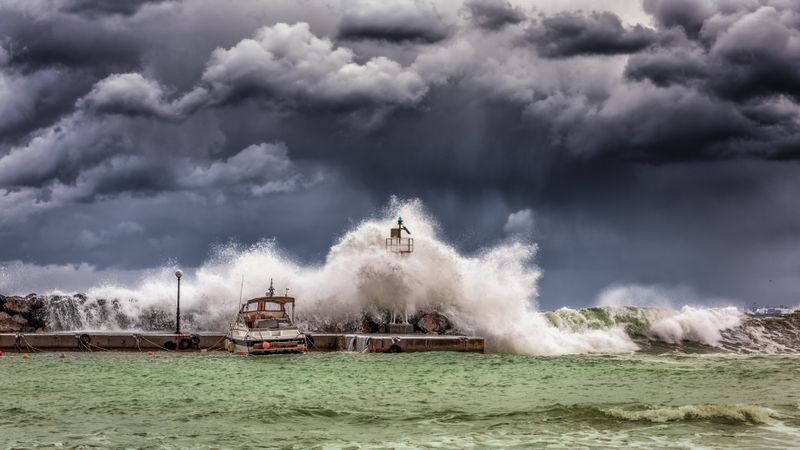A Powerful Storm Knocks Out Power in Houston Area
Introduction
On Wednesday night, a powerful and fast-moving storm system swept through the Houston area, leaving hundreds of thousands of homes and businesses without power. The extent of the damage caused by the storm is still unclear, but it is believed that the storm‘s sustained winds, reaching up to 60 mph, knocked down trees and branches in areas mainly north of Houston.
The Damage and Power Outages
As of 10 p.m. on Wednesday, more than 300,000 CenterPoint Energy customers were reported to be without power, according to the company’s outage tracker. The company has not provided estimates for when power will be restored. The National Weather Service had issued warnings of possible thunderstorms for the evening, and a line of storms began to develop southeast of Dallas around 6 p.m., making its way rapidly southwards. The storm hit the Houston area at around 9 p.m., and preliminary storm data recorded a wind gust of 97 mph at Bush Intercontinental Airport.
Flight Disruptions and Potential Property Damage
Flights to and from Bush Intercontinental Airport were suspended due to the storm, with FlightAware reporting the halt as of 10 p.m. Some reports from the weather service indicate possible damage to planes at David Wayne Hooks Memorial Airport in Spring. The exact extent of the damage in areas like The Woodlands, Spring, and Tomball remains unclear.
Weather Outlook
After the storm passed, temperatures in the region dropped to the mid-70s, which was a welcome respite from the recent heat. However, this cooler weather is not expected to last, with the National Weather Service predicting a return to hot temperatures in the 90s. High humidity will make it feel even hotter, with heat index values ranging from 106 to 110 degrees in most of Southeast Texas. A heat advisory has been issued for the entire day.
Editorial: Climate Change and Extreme Weather Events
As we witness yet another extreme weather event, it is high time that we reflect on the issue of climate change and its impact on our planet. While it is important not to attribute any single weather event solely to climate change, scientific consensus shows that a warming climate contributes to the frequency and intensity of such events.
The increasing intensity of storms, like the one that hit Houston, is a grim reminder of the need to address our carbon emissions and transition to renewable energy sources. The consequences of inaction are dire—more power outages, property damage, and risks to human lives. Our planet is sending us a clear signal that we need to change our ways, and we must heed that call.
Advice: Preparation and Resilience
In the face of frequent extreme weather events, it is crucial for individuals, communities, and governments to be prepared and resilient. Here are some suggestions on how to navigate such situations:
1. Emergency Preparedness:
– Have an emergency kit containing essential supplies like water, non-perishable food, flashlights, batteries, and a first aid kit.
– Create a family emergency plan that includes communication strategies and designated meeting points.
– Stay informed about weather updates and emergency alerts through reliable sources.
2. Power Outage Preparedness:
– Keep a supply of alternative light sources, such as flashlights and candles.
– Ensure you have a backup power source, like a generator or portable power bank, to charge essential devices.
– Unplug sensitive electronics and appliances during storms to protect them from power surges when the power is restored.
3. Property Protection:
– Regularly assess the health of trees on your property and trim branches that could potentially damage your house or power lines.
– Secure loose outdoor objects, such as patio furniture and garbage cans, to prevent them from causing damage during severe weather.
– Consider investing in impact-resistant windows and reinforcing roofs to increase the resilience of your home.
Conclusion
The storm that struck the Houston area, causing widespread power outages and potential property damage, serves as a stark reminder of the growing threat of extreme weather events. As we grapple with the impact of climate change, it is crucial for individuals, communities, and governments to prioritize preparation and resiliency. By taking proactive measures and addressing the root causes of climate change, we can mitigate the impact of future storms and protect our planet for generations to come.

<< photo by GEORGE DESIPRIS >>
The image is for illustrative purposes only and does not depict the actual situation.
You might want to read !
- The Safety of Cruise Ships in Extreme Weather Conditions: Carnival Ship Hit by Waves.
- “Unpredictable Climate Conditions Pose a Threat to Formula 1 Events: Emilia-Romagna Grand Prix Cancelled Due to Devastating Floods in Italy”
- Report: The Collapse of the Celtics’ Trade for Kristaps Porzingis
- The Impact of Victor Wembanyama on the NBA Draft: Taking America by Storm
- Maya Hawke’s Mixed Feelings: A Closer Look at Her Journey in Hollywood
- NBA Trade Rumors: Celtics Eyeing Kristaps Porzingis from the Wizards
- Exploring the aftermath: Assessing the injuries and impact of a gas explosion in central Paris
- The Aftermath of the Paris Explosion: Examining the Impact and the Road to Recovery




